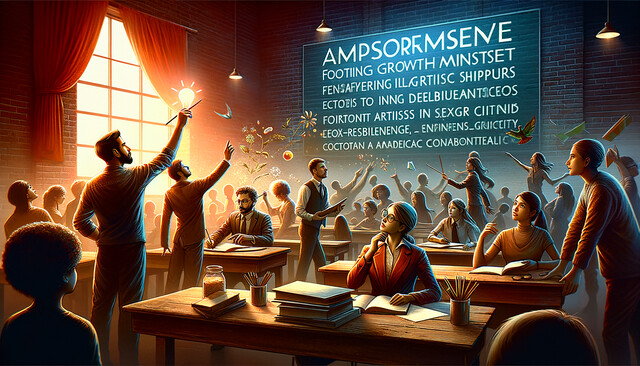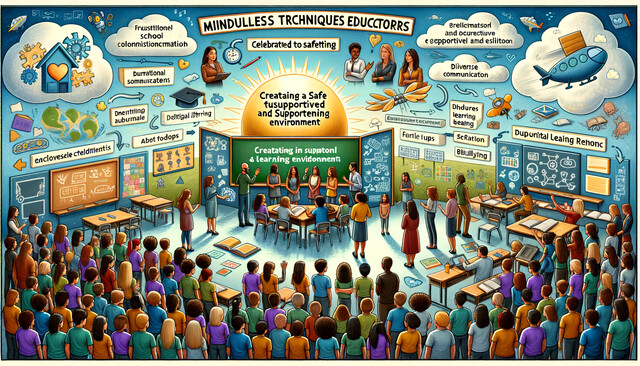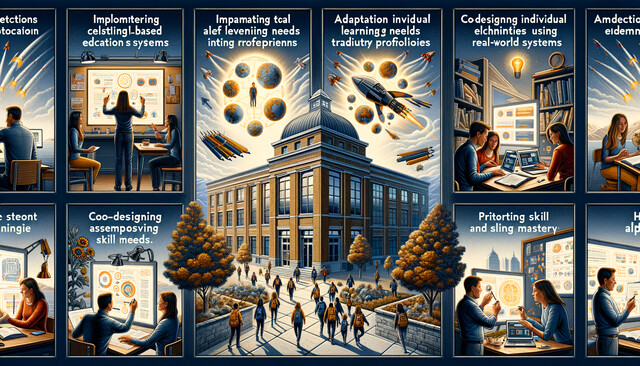Online Class: Strategies for Teaching English Language Learners

no certificate
with CEU Certificate*
-
15Lessons
-
22Exams &
Assignments -
4Hours
average time -
0.4CEUs
Course Description
Imagine walking into a classroom, any classroom, and feeling the vibrant hum of diverse languages intermingling like a beautiful symphony. The atmosphere is charged with potential, each note a unique story, each melody a new cultural perspective waiting to be shared and celebrated. You're not just a passive observer�you're the conductor, orchestrating an environment where every learner thrives. Welcome to "Strategies for Teaching English Language Learners," an essential journey that transforms passionate educators like you into champions of multilingual classrooms.
In today's rapidly shifting educational landscape, understanding how to teach English language learners is more than a skill�it's a superpower. With ELL populations expanding beyond traditional urban centers into rural and suburban schools, the need to adapt teaching strategies to meet these shifts is critical. This course offers a lifeline to educators submerged in these changes, providing not only understanding but mastery of how to shape a truly inclusive educational environment.
Picture delving into Michael Long's Interaction Hypothesis, a theory that brings to life the dance of conversation essential for language growth. Rather than a dry academic concept, imagine learning through stories and real-life examples of how interaction fuels learning, how dialogue not only bridges language gaps but enriches lives. You'll discover how immediate feedback and negotiation of meaning in conversation refine linguistic skills in ways textbooks alone never could.
Transitioning from theory to practice, you'll embark on an adventure toward culturally responsive teaching. Imagine standing in front of a classroom where every student feels seen, valued, and celebrated for their cultural identity. No longer are these diverse backgrounds a challenge to overcome�they're the keys to unlocking engagement and enriched learning outcomes. Through the power of culturally responsive teaching, diversity transforms into your greatest educational ally, enriching classroom experiences and setting new standards for inclusive education.
What if technology were not just a tool, but a bridge to deeper understanding and engagement? Envision harnessing the power of the latest educational technologies, seamlessly integrating them with traditional methods to revolutionize your teaching. Technology becomes a partner in your quest, opening doors to personalized learning pathways and transforming your classroom into a vibrant hub of collaboration and learning.
You're not just arming yourself with knowledge; you're learning to wield it with precision, differentiating your instruction so it meets each student at their own level. This course doesn't just tell you how�it shows you the exquisite dance of differentiating instruction. By integrating culturally relevant materials and using innovative techniques, you'll cultivate a classroom environment where every student feels a deep sense of belonging, inspiring them on a journey of lifelong learning.
Education isn't simply about imparting knowledge; it's about nurturing confident communicators and empowering students to express themselves fully. With a keen focus on language support strategies, be prepared to transform how students use language, encouraging them to take risks, grow in confidence, and embrace their bilingual advantages. Imagine fostering active communication skills that empower students far beyond classroom walls, preparing them for real-world success in any context.
Embark on a reflective journey to enhance cultural competence. You'll face your biases, challenge them, and grow into a more empathetic, understanding educator. This course guides you through the critical process of self-awareness, transforming your approach to teaching and opening your mind to the rich tapestry of experiences your students bring to the classroom.
Ultimately, "Strategies for Teaching English Language Learners" is more than a course; it's a transformative journey that empowers you with innovative strategies to embrace the ever-evolving challenges of teaching ELLs. By the end of this adventure, you'll not only have new tools in your teaching arsenal�you'll have a renewed sense of purpose and passion, ready to inspire and lead a new generation of learners with confidence and compassion.
Join us, and transform yourself from an educator into a seamless bridge builder, connecting cultures, languages, and learners in a world that celebrates diversity. Your classroom will never be the same�and you wouldn't want it any other way.
- Completely Online
- Self-Paced
- 6 Months to Complete
- 24/7 Availability
- Start Anytime
- PC & Mac Compatible
- Android & iOS Friendly
- Accredited CEUs

Course Lessons
Lesson 1. Adaptation and Growth: Understanding ELL Geographical Dispersal
 Review Practice Worksheet: Lesson-1-WordSearch-17060.pdf
Review Practice Worksheet: Lesson-1-WordSearch-17060.pdf Lesson discussions: Reasons for Taking this Course
Lesson discussions: Reasons for Taking this Course Assessment: Lesson 1 Review Exam
Assessment: Lesson 1 Review Exam
Lesson 2. Unlocking the Secrets of Second Language Learning
 Review Practice Worksheet: Lesson-2-Activity-17062.pdf
Review Practice Worksheet: Lesson-2-Activity-17062.pdf Complete: Lesson 2 Activity
Complete: Lesson 2 Activity Assessment: Lesson 2 Review Exam
Assessment: Lesson 2 Review Exam
Lesson 3. Transforming Language Acquisition Through Culturally Responsive Teaching
 Review Practice Worksheet: Lesson-3-Downloadable-17065.pdf
Review Practice Worksheet: Lesson-3-Downloadable-17065.pdf Complete: Lesson 3 Activity
Complete: Lesson 3 Activity Assessment: Lesson 3 Review Exam
Assessment: Lesson 3 Review Exam
Lesson 4. Bridging Communication Gaps: Effective Techniques for ELL Classrooms
 Review Practice Worksheet: Lesson-4-WordSearch-17066.pdf
Review Practice Worksheet: Lesson-4-WordSearch-17066.pdf Complete: Lesson 4 Activity
Complete: Lesson 4 Activity Assessment: Lesson 4 Review Exam
Assessment: Lesson 4 Review Exam
Lesson 5. Illuminating Pathways: Differentiating Instruction for ELLs
 Review Practice Worksheet: Lesson-5-Activity-17069.pdf
Review Practice Worksheet: Lesson-5-Activity-17069.pdf Assessment: Lesson 5 Review Exam
Assessment: Lesson 5 Review Exam
Lesson 6. Interactive Learning for Language Acquisition
 Review Practice Worksheet: Lesson-6-WorkSheet-17071.pdf
Review Practice Worksheet: Lesson-6-WorkSheet-17071.pdf Complete: Lesson 6 Activity
Complete: Lesson 6 Activity Assessment: Lesson 6 Review Exam
Assessment: Lesson 6 Review Exam
Lesson 7. Embracing Culture: CRP's Transformative Impact on ELL Education
 Review Practice Worksheet: Lesson-7-HomeWork-17074.pdf
Review Practice Worksheet: Lesson-7-HomeWork-17074.pdf Complete: Lesson 7 Activity
Complete: Lesson 7 Activity Assessment: Lesson 7 Review Exam
Assessment: Lesson 7 Review Exam
Lesson 8. Leveraging Language Assessments to Empower English Learners
 Review Practice Worksheet: Lesson-8-WordSearch-17076.pdf
Review Practice Worksheet: Lesson-8-WordSearch-17076.pdf Assessment: Lesson 8 Review Exam
Assessment: Lesson 8 Review Exam
Lesson 9. Harnessing Technology: Transforming English Language Learning
 Review Practice Worksheet: Lesson-9-WordSearch-17078.pdf
Review Practice Worksheet: Lesson-9-WordSearch-17078.pdf Complete: Lesson 9 Activity
Complete: Lesson 9 Activity Assessment: Lesson 9 Review Exam
Assessment: Lesson 9 Review Exam
Lesson 10. Mastering Tiered Vocabulary for ELLs
 Review Practice Worksheet: Lesson-10-HomeWork-17081.pdf
Review Practice Worksheet: Lesson-10-HomeWork-17081.pdf Complete: Lesson 10 Activity
Complete: Lesson 10 Activity Assessment: Lesson 10 Review Exam
Assessment: Lesson 10 Review Exam
Lesson 11. Diverse Linguistics: Enhancing ELL Reading Skills
 Review Practice Worksheet: Lesson-11-Activity-17083.pdf
Review Practice Worksheet: Lesson-11-Activity-17083.pdf Assessment: Lesson 11 Review Exam
Assessment: Lesson 11 Review Exam
Lesson 12. Harnessing Writing as a Tool for Linguistic Growth in ELLs
 Review Practice Worksheet: Lesson-12-WordSearch-17085.pdf
Review Practice Worksheet: Lesson-12-WordSearch-17085.pdf Assessment: Lesson 12 Review Exam
Assessment: Lesson 12 Review Exam
Lesson 13. Cultivating Confident Communicators: Active Listening for ELLs
 Review Practice Worksheet: Lesson-13-Activity-17088.pdf
Review Practice Worksheet: Lesson-13-Activity-17088.pdf Assessment: Lesson 13 Review Exam
Assessment: Lesson 13 Review Exam
Lesson 14. Cultural Competence for Educators
 Review Practice Worksheet: Lesson-14-WorkSheet-17091.pdf
Review Practice Worksheet: Lesson-14-WorkSheet-17091.pdf Assessment: Lesson 14 Review Exam
Assessment: Lesson 14 Review Exam
Lesson 15. Innovative Strategies for ELL Instruction
 Review Practice Worksheet: Lesson-15-WorkSheet-17093.pdf
Review Practice Worksheet: Lesson-15-WorkSheet-17093.pdf Lesson discussions: End of Course Poll; Course Comments
Lesson discussions: End of Course Poll; Course Comments Assessment: Lesson 15 Review Exam
Assessment: Lesson 15 Review Exam
Learning Outcomes
- Identify and evaluate the challenges ELLs face in U.S. schools and propose solutions to support their academic and social integration.
- Recognize and describe the diverse linguistic and cultural backgrounds of English Language Learners (ELLs) and their impact on educational strategies.
- Define and compare key theories of second language acquisition, including behaviorist, cognitive, sociocultural, and interactionist perspectives, by analyzing underlying principles and methodologies.
- Demonstrate understanding of individual differences in second language acquisition by identifying factors such as motivation, age, and technology that affect language learning success.
- Design culturally responsive lesson plans that incorporate students' cultural heritages and align with varied educational backgrounds to enhance English language proficiency.
- Identify and distinguish the phonetic variations in English pronunciation experienced by ELL students from diverse linguistic backgrounds.
- Define at least three strategies to foster trust and connection with ELL students to improve classroom engagement.
- Demonstrate the integration of visual aids and storytelling techniques to enhance comprehension among ELL students.
- Define differentiated instruction and explain how it addresses the diverse needs of English Language Learners in a classroom setting.
- Demonstrate the ability to apply differentiation strategies by creating a lesson plan that incorporates content, process, and product differentiation for ELL students.
- Demonstrate the ability to construct and utilize sentence starters provided through language support strategies to facilitate sentence formation and vocabulary acquisition in ELL contexts.
- Describe how visual aids and graphic organizers enhance comprehension and retention in ELL students by simplifying complex information into accessible formats.
- Define key elements of Culturally Relevant Pedagogy that promote academic success among English Language Learners by integrating students' cultural backgrounds into the classroom.
- Demonstrate mastery of lesson content at levels of 70% or higher.
Additional Course Information

- Document Your Lifelong Learning Achievements
- Earn an Official Certificate Documenting Course Hours and CEUs
- Verify Your Certificate with a Unique Serial Number Online
- View and Share Your Certificate Online or Download/Print as PDF
- Display Your Certificate on Your Resume and Promote Your Achievements Using Social Media

Choose Your Subscription Plan
No Certificate / No CEUs
This course only
| Includes certificate | X |
| Includes CEUs | X |
| Self-paced |

|
| Instructor support |

|
| Time to complete | 6 months |
| No. of courses | 1 course |
Certificate & CEUs
This course only
| Includes certificate |

|
| Includes CEUs |

|
| Self-paced |

|
| Instructor support |

|
| Time to complete | 6 months |
| No. of courses | 1 course |
Certificates & CEUs
Includes all 600+ courses
| Includes certificate |

|
| Includes CEUs |

|
| Self-paced |

|
| Instructor support |

|
| Time to complete | 12 Months |
| No. of courses | 600+ |
Certificates & CEUs
Includes all 600+ courses
| Includes certificate |

|
| Includes CEUs |

|
| Self-paced |

|
| Instructor support |

|
| Time to complete | 24 Months |
| No. of courses | 600+ |
Related Courses
-
 5 hours
0.5 CEUs
Maximizing Learning with Flipped Classrooms
+ More Info
5 hours
0.5 CEUs
Maximizing Learning with Flipped Classrooms
+ More Info
-
 7 hours
0.7 CEUs
Developing Academic Language Skills
+ More Info
7 hours
0.7 CEUs
Developing Academic Language Skills
+ More Info
-
 6 hours
0.6 CEUs
Differentiated Instruction Techniques
+ More Info
6 hours
0.6 CEUs
Differentiated Instruction Techniques
+ More Info
-
 6 hours
0.6 CEUs
Classroom Management for New Teachers
+ More Info
6 hours
0.6 CEUs
Classroom Management for New Teachers
+ More Info
-
 7 hours
0.7 CEUs
Integrating Arts into the Curriculum
+ More Info
7 hours
0.7 CEUs
Integrating Arts into the Curriculum
+ More Info
-
 6 hours
0.6 CEUs
Narrative Approaches in Education
+ More Info
6 hours
0.6 CEUs
Narrative Approaches in Education
+ More Info
-
 7 hours
0.7 CEUs
Leadership in Educational Settings
+ More Info
7 hours
0.7 CEUs
Leadership in Educational Settings
+ More Info
-
 5 hours
0.5 CEUs
STEAM: Integrating the Arts with STEM
+ More Info
5 hours
0.5 CEUs
STEAM: Integrating the Arts with STEM
+ More Info
-
 5 hours
0.5 CEUs
Implementing RTI Models in Schools
+ More Info
5 hours
0.5 CEUs
Implementing RTI Models in Schools
+ More Info
-
 6 hours
0.6 CEUs
Social and Emotional Learning: Programs and Practices
+ More Info
6 hours
0.6 CEUs
Social and Emotional Learning: Programs and Practices
+ More Info
-
 3 hours
0.3 CEUs
Designing STEM Curriculum
+ More Info
3 hours
0.3 CEUs
Designing STEM Curriculum
+ More Info
-
 5 hours
0.5 CEUs
Mindfulness Techniques for Educators
+ More Info
5 hours
0.5 CEUs
Mindfulness Techniques for Educators
+ More Info
-
 3 hours
0.3 CEUs
Preparing Students for Careers of the Future
+ More Info
3 hours
0.3 CEUs
Preparing Students for Careers of the Future
+ More Info
-
 3 hours
0.3 CEUs
Collaborative Teaching Approaches
+ More Info
3 hours
0.3 CEUs
Collaborative Teaching Approaches
+ More Info
-
 3 hours
0.3 CEUs
Improving Teacher Retention and Sustainability
+ More Info
3 hours
0.3 CEUs
Improving Teacher Retention and Sustainability
+ More Info
-
 3 hours
0.3 CEUs
Education Policy and Reform: Impact and Implications
+ More Info
3 hours
0.3 CEUs
Education Policy and Reform: Impact and Implications
+ More Info
-
 5 hours
0.5 CEUs
Implementing Evidence-Based Practices
+ More Info
5 hours
0.5 CEUs
Implementing Evidence-Based Practices
+ More Info
-
 4 hours
0.4 CEUs
Principles of Adult Learning Theory
+ More Info
4 hours
0.4 CEUs
Principles of Adult Learning Theory
+ More Info
-
 4 hours
0.4 CEUs
Implementing Competency-Based Education Systems
+ More Info
4 hours
0.4 CEUs
Implementing Competency-Based Education Systems
+ More Info
-
 4 hours
0.4 CEUs
Developing Emotional Intelligence in Educators
+ More Info
4 hours
0.4 CEUs
Developing Emotional Intelligence in Educators
+ More Info
-
 5 hours
0.5 CEUs
Creating a Safe and Supportive Learning Environment
+ More Info
5 hours
0.5 CEUs
Creating a Safe and Supportive Learning Environment
+ More Info
-
 7 hours
0.7 CEUs
Blended Learning Models in Schools
+ More Info
7 hours
0.7 CEUs
Blended Learning Models in Schools
+ More Info
-
 4 hours
0.4 CEUs
The Use of Analytics in Education
+ More Info
4 hours
0.4 CEUs
The Use of Analytics in Education
+ More Info
-
 7 hours
0.7 CEUs
Integrating Technology in Education
+ More Info
7 hours
0.7 CEUs
Integrating Technology in Education
+ More Info
-
 5 hours
0.5 CEUs
Engaging Families in the Educative Process
+ More Info
5 hours
0.5 CEUs
Engaging Families in the Educative Process
+ More Info
-
 5 hours
0.5 CEUs
Inquiry-Based Learning Strategies
+ More Info
5 hours
0.5 CEUs
Inquiry-Based Learning Strategies
+ More Info
-
 7 hours
0.7 CEUs
Strategies for Closing the Achievement Gap
+ More Info
7 hours
0.7 CEUs
Strategies for Closing the Achievement Gap
+ More Info
-
 5 hours
0.5 CEUs
Utilizing Data to Drive Instruction
+ More Info
5 hours
0.5 CEUs
Utilizing Data to Drive Instruction
+ More Info
-
 3 hours
0.3 CEUs
Empowering Students through Self-Assessment
+ More Info
3 hours
0.3 CEUs
Empowering Students through Self-Assessment
+ More Info
-
 3 hours
0.3 CEUs
Effective Literacy Instruction in Early Education
+ More Info
3 hours
0.3 CEUs
Effective Literacy Instruction in Early Education
+ More Info
-
 7 hours
0.7 CEUs
Introduction to Instructional Design
+ More Info
7 hours
0.7 CEUs
Introduction to Instructional Design
+ More Info
-
 4 hours
0.4 CEUs
Implementing Project-Based Learning
+ More Info
4 hours
0.4 CEUs
Implementing Project-Based Learning
+ More Info
-
 4 hours
0.4 CEUs
Enhancing Student Engagement and Motivation
+ More Info
4 hours
0.4 CEUs
Enhancing Student Engagement and Motivation
+ More Info
-
 4 hours
0.4 CEUs
Facilitating Online and Hybrid Learning
+ More Info
4 hours
0.4 CEUs
Facilitating Online and Hybrid Learning
+ More Info
-
 6 hours
0.6 CEUs
Professional Learning Communities Development
+ More Info
6 hours
0.6 CEUs
Professional Learning Communities Development
+ More Info
-
 4 hours
0.4 CEUs
Creating a Culture of Collaboration
+ More Info
4 hours
0.4 CEUs
Creating a Culture of Collaboration
+ More Info
-
 7 hours
0.7 CEUs
Designing Interdisciplinary Curricula
+ More Info
7 hours
0.7 CEUs
Designing Interdisciplinary Curricula
+ More Info
-
 4 hours
0.4 CEUs
Gamification in Education
+ More Info
4 hours
0.4 CEUs
Gamification in Education
+ More Info
-
 3 hours
0.3 CEUs
Historical Perspectives in Curriculum Development
+ More Info
3 hours
0.3 CEUs
Historical Perspectives in Curriculum Development
+ More Info




